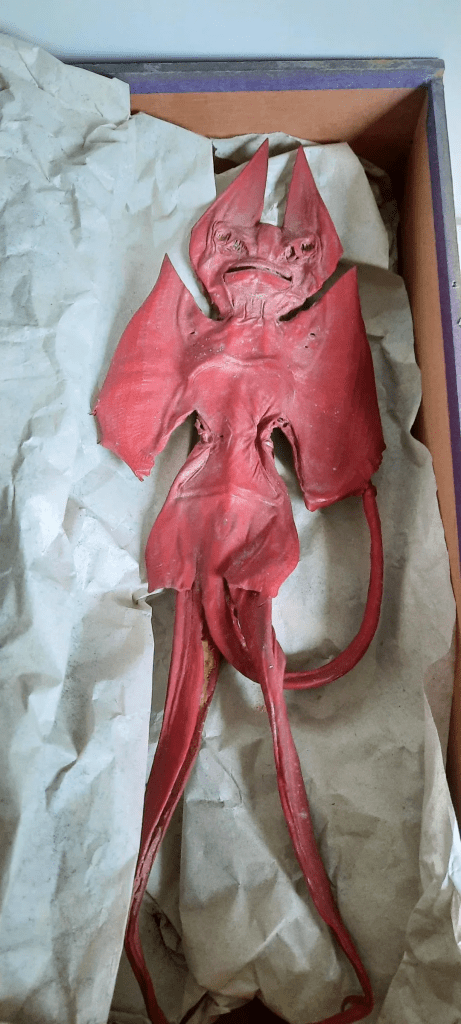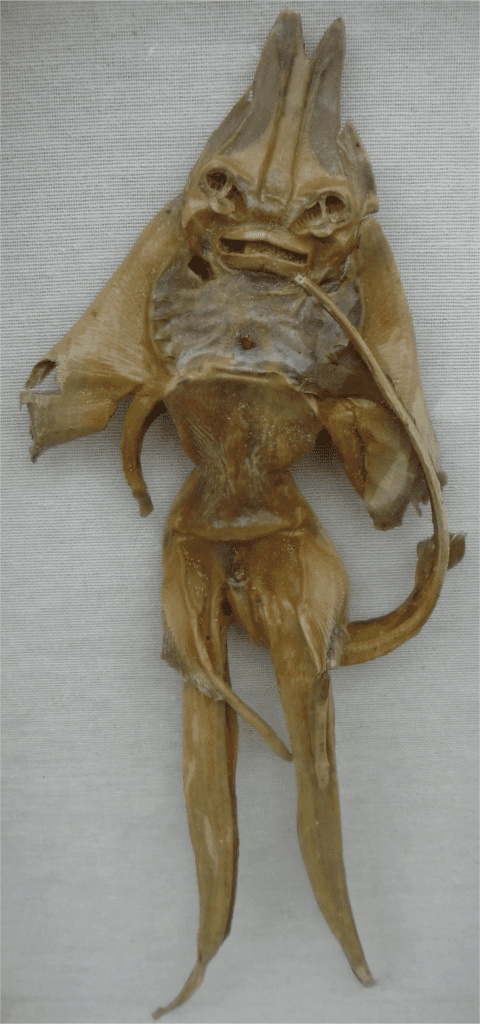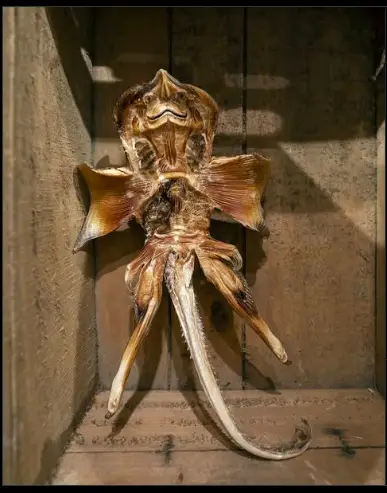During the Age of Exploration, sailors returned from their voyages with tales of fantastical creatures and strange artifacts that captured the imaginations of those at home. Among these curiosities, one of the most peculiar was the Jenny Haniver—a grotesque and mythical “creature” crafted from the dried and manipulated bodies of rays or skates. These eerie creations blurred the line between reality and legend, offering a glimpse into the creativity and cunning of sailors who capitalized on the public’s fascination with the unknown.

What Exactly is a Jenny Haniver?
A Jenny Haniver is a hoax—an artistic manipulation of a ray or skate fish to resemble a mythical sea creature. Using a combination of drying, carving, and shaping techniques, sailors transformed these marine animals into bizarre figures that appeared to be part-human, part-monster. These creatures often had grotesque faces, exaggerated fins, and eerie “arms” or “legs,” giving them an unsettling, otherworldly appearance.
The Jenny Hanivers were marketed as real evidence of mythical beings like mermaids, sea devils, or sea monsters. They were sold to curious tourists, collectors, and traders eager for exotic and mysterious souvenirs, making them a profitable venture for resourceful sailors.
The Art of Crafting Jenny Hanivers
Creating a Jenny Haniver wasn’t just a hobby—it was a skill that required precision and imagination. The process began with capturing a ray or skate, fish species with cartilaginous bodies and wide, flat fins. The fish would then be dried in the sun or preserved with salt, a method that also helped them harden into a manageable form.
Once the body was ready, the sailor would begin the transformation. Using knives, tools, and sometimes even their bare hands, they would bend, cut, and mold the fish into shapes resembling humanoid or monstrous figures. Features like eyes and mouths were often carved into the hardened fish to enhance their lifelike and terrifying appearance.
Some sailors took the craft even further by adding materials like shells, paint, or fabric to make their creations even more elaborate and believable. These artistic touches turned a simple dried fish into an intricate work of mythical art, designed to captivate and deceive.

Why Did Sailors Make Jenny Hanivers?
During the 16th and 17th centuries, the public was enamored with tales of distant lands, exotic creatures, and the supernatural. Sailors, who spent months or years at sea, were eager to capitalize on this fascination. Selling Jenny Hanivers became a clever way to earn extra money, especially for sailors who often struggled financially.
The creations fed into the public’s appetite for mystery and adventure, offering a tangible piece of the fantastical stories sailors brought back from their travels. For buyers, owning a Jenny Haniver was like holding a piece of the ocean’s secrets—a testament to the wonders that lay beyond the horizon.

The Mythical Allure of Jenny Hanivers
To the untrained eye, Jenny Hanivers were captivating and terrifying. They were sold as evidence of sea monsters, devil fish, or even mermaids—creatures that sailors claimed to have encountered during their voyages. This added to the mystique surrounding the ocean, a realm that was still largely unexplored and shrouded in superstition.
In an era when scientific understanding was limited, many people believed in the existence of mythical creatures. Jenny Hanivers played into these beliefs, serving as “proof” that the world was far stranger than anyone could imagine.
The Decline of the Jenny Haniver Craze
As scientific knowledge grew and the mysteries of the ocean became more understood, the allure of Jenny Hanivers began to wane. By the 19th and 20th centuries, these creations were no longer seen as evidence of mythical creatures but rather as amusing curiosities or folk art.
Although their popularity declined, Jenny Hanivers never fully disappeared. Some collectors and enthusiasts continued to craft them, not as hoaxes but as tributes to a bygone era of maritime folklore. Today, they can be found in museums, private collections, and occasional curiosity shops, serving as reminders of humanity’s enduring fascination with the unknown.
Jenny Hanivers in Modern Times
Though rare, Jenny Hanivers still hold a place in maritime history and popular culture. They are often displayed as historical artifacts, highlighting the creativity and resourcefulness of sailors during the Age of Exploration. Some modern artists and collectors even create Jenny Hanivers as a nod to this unique maritime tradition.
Rather than being passed off as real sea creatures, today’s Jenny Hanivers are appreciated for their craftsmanship and historical significance. They remain a quirky, tangible connection to a time when myths and reality often blurred.
The Legacy of Jenny Hanivers
The Jenny Haniver is more than just a dried fish turned into a creepy souvenir—it’s a symbol of humanity’s curiosity, creativity, and desire to believe in the extraordinary. These oddities represent a time when the ocean was a mysterious and magical frontier, and when storytelling and craftsmanship merged to create lasting legends.
For modern audiences, Jenny Hanivers serve as fascinating relics of maritime history. They remind us of the power of imagination and the lengths people will go to capture the wonder of the unknown. The next time you encounter one of these strange creatures, take a moment to appreciate the story it tells—a story of sailors, myths, and the enduring allure of the sea.